The Scottish Shelf Model. Part 2: Pentland Firth and Orkney Waters Sub-Domain
Part 2 of the hydrodynamic model developed for Scottish waters.
2 Available data for model development
2.1 Introduction
In order to carry out the numerical modelling works for the Pentland Firth and Orkney Waters ( PFOW), the following data have been collated and/or identified:
- Bathymetry data, required for creating the bathymetry for the numerical model.
- Forcing data, required for specifying the forcing conditions in the numerical wave and flow models.
- Calibration and validation data, required for calibrating and validating the numerical models.
This section of the report describes the data collated/identified for the Pentland Firth and Orkney Waters ( PFOW) model area. Where appropriate, reference is made to the overall project data review report (Halcrow, 2012). Note that the proposed model domains shown are not the final model domains but an approximation.
2.2 Bathymetric Data
2.2.1 Coastline Data
Two coastline data sets have been obtained for use in this study the Global Self-consistent, Hierarchical, High-resolution Shoreline ( GSHHS) distributed by National Geophysical Data Centre ( NGDC) in the US, and Ordnance Survey Mapping.
The GSHHS coastline comes in different resolutions. For the UK, the best resolution available is the World Vector Shoreline ( WVS) designed to be used at a resolution of 1:250,000. The GSHHS coastlines have been data processed to ensure they are free of internal inconsistencies such as erratic points and crossing segments.
The Ordnance Survey ( OS) Vector Map District contains tidal boundary polylines, which are at Mean High Water Spring level ( MHWS) in Scotland and MHW in England and Wales. These are at higher spatial resolution than the GSHHS shoreline dataset. Figure 2-1 shows both the OS Vector Map District tidal boundary and the GSHHS shoreline dataset for the Pentland Firth area. False islands occur over the Pentland Skerries in the GSHHS shoreline data set, which are shown as lying between the MLWS and MHWS boundaries in the Ordnance Survey Vector Map District dataset. The GSHHS data is considered appropriate for use in areas where the model resolution is coarse, the OS vector map district MHWS line was used in areas of higher resolution, such as for the Pentland Firth and Orkney Waters.
2.2.2 Global/Regional Gridded Data Sets
Three existing coarse resolution bathymetry data sets have been identified which cover the study area the GEBCO_08, the ETOPO-1 grid and the EMODnet grid. These are described briefly below. Details regarding these datasets are provided in Halcrow (2012).
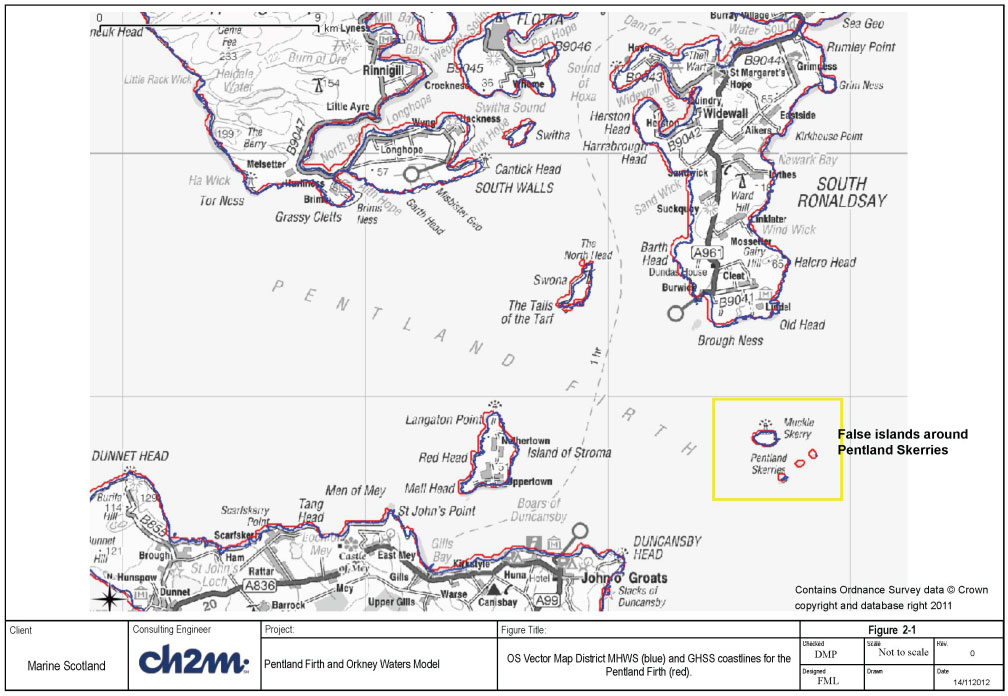
2.2.2.1 General Bathymetric Chart of the Oceans ( GEBCO)
The GEBCO_08 data set is a global DTM at 0.5 minute resolution generated from a database of bathymetric soundings with interpolation between soundings guided by satellite-derived gravity data. The dataset is produced by GEBCO ( http://www.gebco.net).
Known errors or discontinuities in the data set occur between regions where data is derived from satellite data and detailed bathymetric survey - this is evident in a grid pattern in the Southern North Sea Region, and a discontinuity at 0°E. Marine Scotland has highlighted errors where false banks occur on the shelf around the Shetland Island (Hughes, 2014).
Figure 2-2 shows the GEBCO_08 bathymetry for the British Shelf and the source of the data. The discontinuity at 0°E and the grid pattern in the North Sea are clearly visible.
2.2.2.2 ETOPO-1
ETOPO-1 is a global DTM at 1 minute resolution produced by NOAA National Geophysical Data Center. The documentation states that this uses the GEBCO_08 data set for the British Shelf. Due to the lower resolution this dataset has not been considered further.
2.2.2.3 European Marine Observation and Data Network ( EMODnet)
The European Marine Observation and Data Network ( EMODnet) have produced DTMs for the Greater North Sea and Celtic Seas at 0.25 minute resolution (about 250m east-west direction and 450m north-south directions). The grids are based on bathymetric surveys and terrain models developed by external data providers including the UK Hydrographic Office ( UKHO), and the GEBCO_08 Grid 0.5 minute resolution dataset where no other data is available. Data sets are made available through the EMODnet website http://www.emodnet-hydrography.eu/
Further details of EMODnet are provided in Halcrow (2012).
Figure 2-3 shows where UK Hydrographic office data has been incorporated into the EMODnet dataset and the differences between the EMODnet and GEBCO_08 bathymetry. Comparison of the EMODnet and GEBCO_08 data sets shows significant differences where the data from the UKHO and other hydrographic offices has been included. Differences are generally greater in areas where the GEBCO_08 has been interpolated, and the UKHO data has been used in the EMODnet bathymetry, for example around 1.5°W 56.3°N, due east of the Firth of Tay. The large differences west of Norway are due to incorporation of Norwegian hydrographic office data. There are also differences north west of the British Shelf around Iceland, where the EMODnet data is sourced from the GEBCO_08 grid. However these have not been investigated as they are not considered important for the study area.
Due to the inclusion of the majority of the UKHO data, the EMODnet bathymetry is considered appropriate for use as the base bathymetry for model construction in areas where the resolution was in the order of one kilometre. Higher resolution bathymetry data is however required in areas where the model mesh is finer to represent bed or flow features. Therefore other datasets are required as described below.
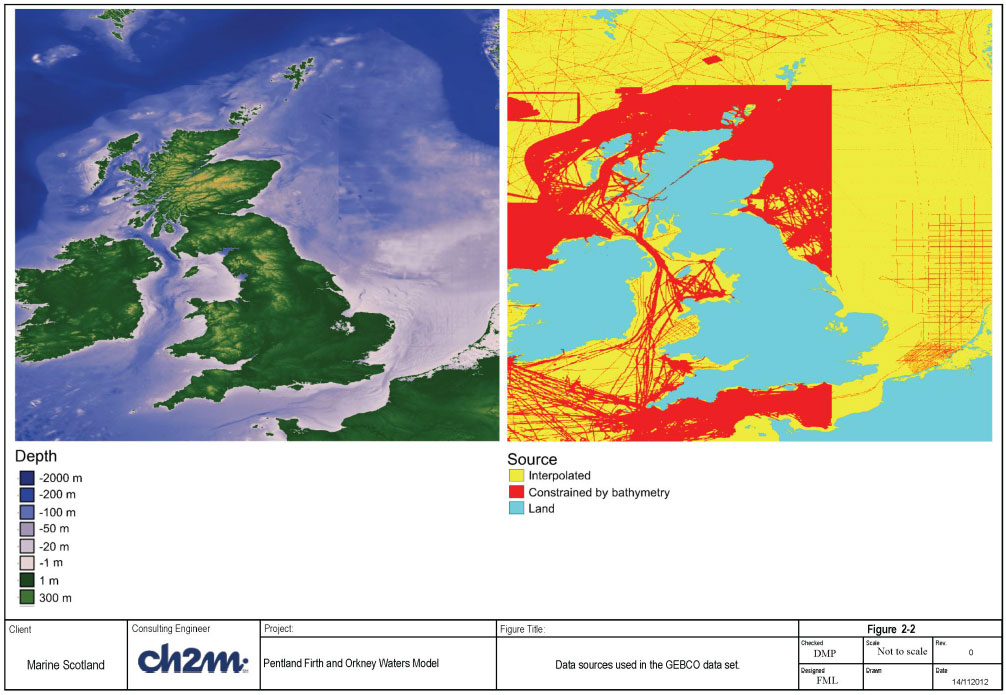
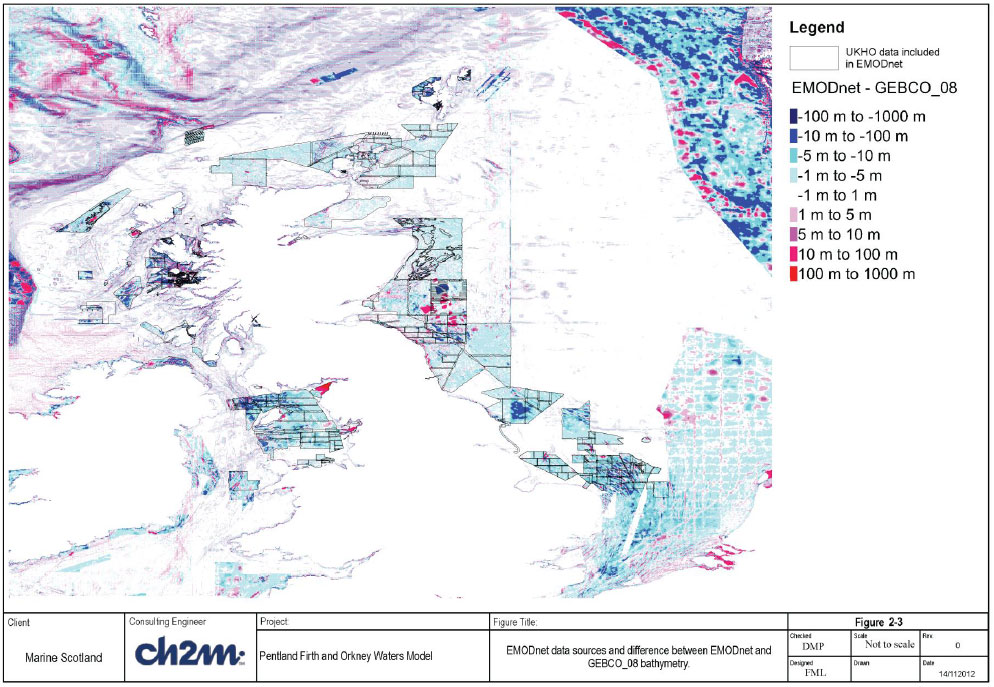
2.2.3 Hydrographic Data
Three sources of hydrographic survey data have been identified; the United Kingdom Hydrographic Office ( UKHO), the International Council for Exploration of the Sea ( ICES) and Marine Scotland's data sets.
The UKHO have a memorandum of understanding with Marine Scotland making their high resolution bathymetric survey available. Most of these data have already been incorporated into the EMODnet bathymetry, however further data has since become available. The location of the UKHO data is shown in Figure 2-3 (also Figure 2-4 for smaller areas of sea). Marine Scotland has carried out recent bathymetric surveys for the Pentland Firth which are not listed in the UK Hydrographic office data sets.
The ICES surface dataset holds over 100 years of ship based observations, including soundings. There are over 2 million data points in the ICES data set within the study area, providing a good coverage over most areas. The ICES website ( http://ocean.ices.dk/) states that data are quality controlled by contributing organisation and visually inspected by experienced staff to further improve the quality of these data. However it is expected that due to the age of some of the sounding data and the differences in measurement methods, data logging and processing that there may be significant differences or scatter between the soundings. Marine Scotland used the ICES dataset to identify and correct anomalies in the GEBCO_08 data set off the coast of Shetland. See Halcrow, 2012, for more detail regarding hydrographic data and the differences observed between datasets.
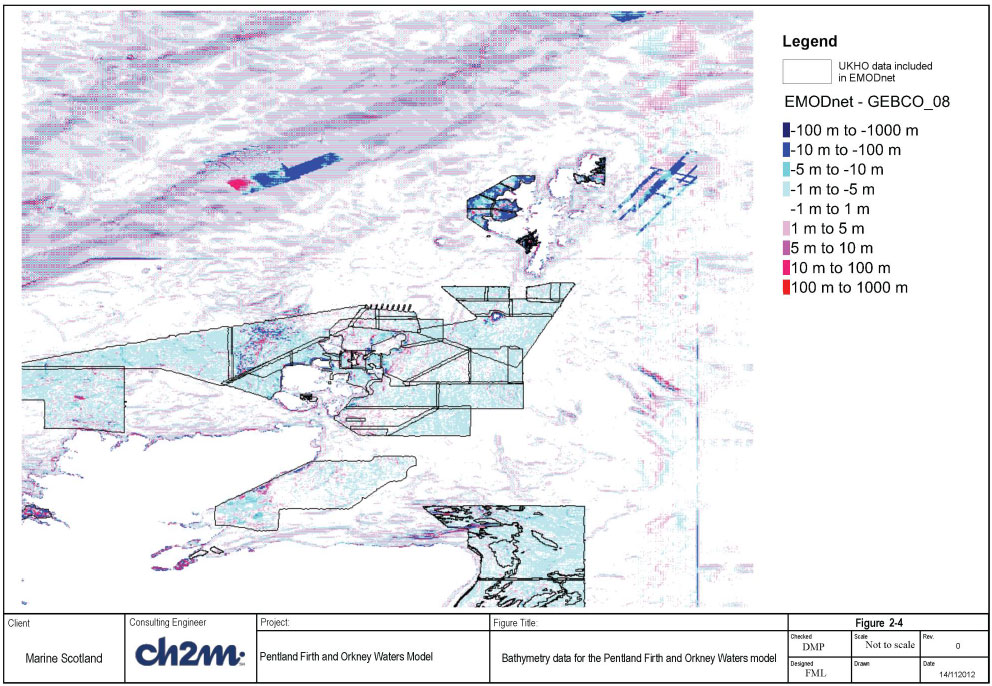
2.2.4 NOOS 1.0
NOOS 1.0: A gridded dataset for the UK continental shelf at 1 arc-minute resolution was produced under the aegis of NOOS (an operational oceanography organisation for the NW European Shelf (see Halcrow, 2012 for more information). The NOOS bathymetry incorporates local datasets made available by oceanographic institutions in countries around the North Sea, however no detailed source attribution information is available for the bathymetry, and it was last revised in 2004. Bathymetric surveys collected by the UKHO post 2004 are therefore not incorporated in to the bathymetry, and it is uncertain to what extent earlier UKHO and other national hydrographic office datasets were incorporated.
The NOOS bathymetry as gridded in the NOC-L high resolution continental shelf model (1.5 minute by 1 minute resolution) was compared with ICES ship track soundings and the EMODnet bathymetry. The NOOS bathymetry does not have a discontinuity in the North Sea at 0°E and is more consistent with the ICES ship track soundings than the EMODnet bathymetry east of 0°E. The false islands in the EMODnet and GEBCO bathymetry east and north east of Shetland are not present in the NOOS bathymetry. It is therefore considered more appropriate to use the NOOS bathymetry than the EMODnet bathymetry for the PFOW and the shelf model in the North Sea east of 0°E, except in areas where it is known that UKHO data has been incorporated into the EMODnet bathymetry. Where UKHO data has been incorporated into the EMODnet bathymetry the difference between the EMODnet bathymetry and the ICES ship track soundings is less than for the NOOS bathymetry. As the EMODnet bathymetry is also at higher resolution it is not considered appropriate to use the NOOS bathymetry east of 0°E where it is known than hydrographic office data has been incorporated into the EMODnet bathymetry.
However, south east of Shetland (0.1°W,59.6°N to 0.2°E 60°N) the NOOS bathymetry is shallower than the EMODnet bathymetry and less consistent with the ICES ship track soundings, and comparison with chart data is needed in this region. Differences between the NOOS bathymetry and the ICES ship track soundings are also larger than for the EMODnet bathymetry for the west of Scotland, including the Inner and Outer Hebrides. It is therefore not considered appropriate to use the NOOS bathymetry west of 0°E.
2.2.5 Other data sources
Other identified data sources include digital Admiralty charts (C-MAP) and SeaZone. However, these datasets were not used for this study due to licensing restrictions as discussed fully in Halcrow (2012). A licence enabling Halcrow to digitise the required Admiralty Charts was obtained from the Hydrographic Office and the digitising undertaken. This allows the data to be used into the future for this project without paying a licence fee every year. The digitised Admiralty Charts are used to fill the gaps in the digital bathymetry data available for the PFOW model.
2.2.6 Summary of bathymetry data availability for the Pentland Firth and Orkney Waters Area
This section summarises the availability of bathymetry data for PFOW area.
High resolution bathymetric data is available, for most of the core study area of the Pentland Firth and Orkney Islands. Figure 2-4 shows the availability of bathymetric data for the Pentland Firth and Orkney Waters model (excluding Admiralty Charts). EMODnet formed the base bathymetry with the NOOS data providing depths to the east of longitude 0°E. The small areas of coloured bathymetry shown in Figure 2-4 show higher resolution data obtained from the UKHO.
Figure 2-5 shows a comparison of bathymetry profiles from Marine Scotland surveys and EMODnet data at three sections A-B, C-D and E-F. The locations of these sections are indicated in Figure 2.4. The Armadale bathymetry (section A-B) is offset by 10m from the GEBCO_08 dataset, however agreement between the Pentland Firth survey (sections C-D and E-F) and the GEBCO_08 dataset is good.
A detailed map of data availability for the Orkney Islands and Pentland Firth is shown in Figure 2-6. Detailed bathymetric survey data is missing between the shore and 3000 m to the east of South Ronaldsay, Burray and the mainland, to South West of Hoy and for many of the passages between the islands. It is the areas with a blue background that was supplemented with digitised Admiralty Chart data.
A detailed map of data availability for the Shetland Islands in the north of the proposed model domain is shown in Figure 2-7. For the Shetland Islands there is no high resolution data east of the Mainland and through the Yell Sound. This data was supplemented with digitised Admiralty Chart data.
To summarise, there appears generally to be sufficient bathymetry data in the open water areas, however there is limited data in the channels within the islands of Orkney and Shetland as well as in the shallow areas of these islands. These gaps have been filled with data obtained by digitising the appropriate Admiralty Charts (after first obtaining a licence to do so from the Hydrographic Office).
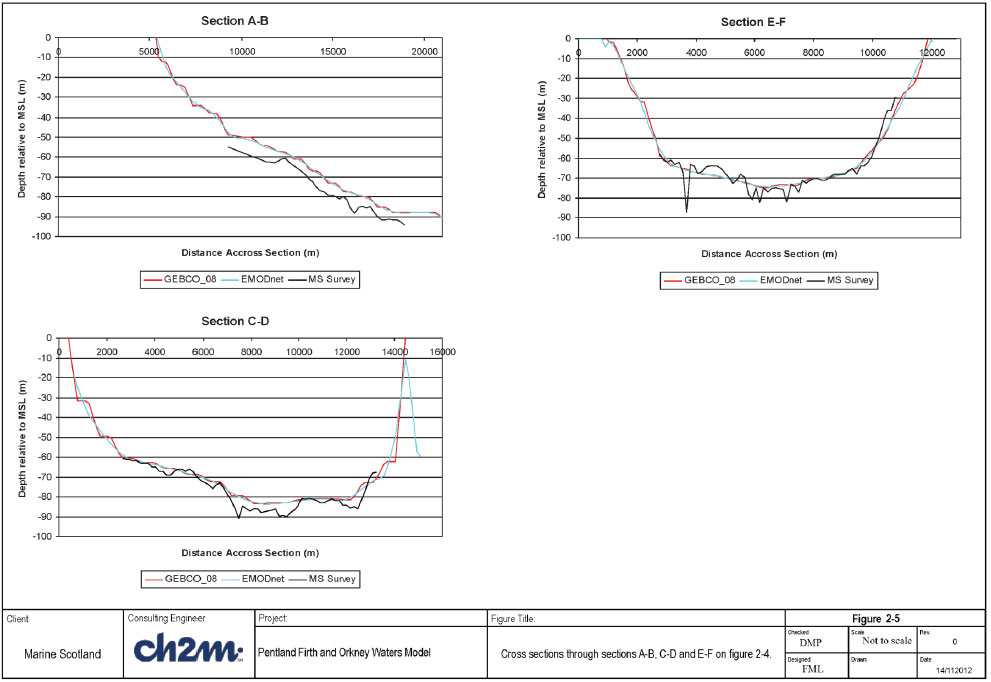
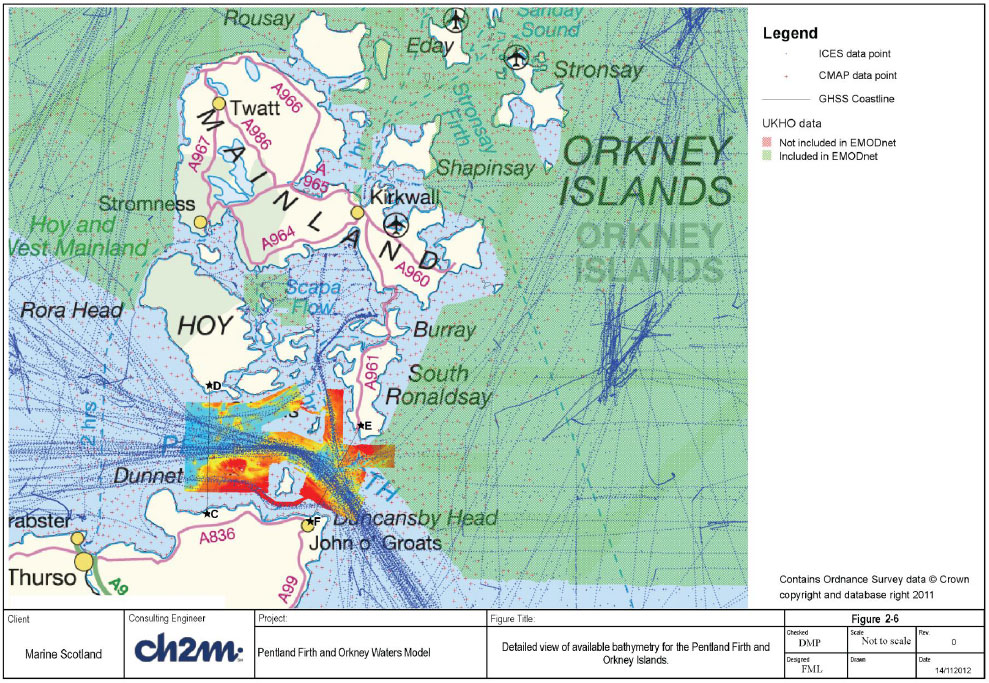
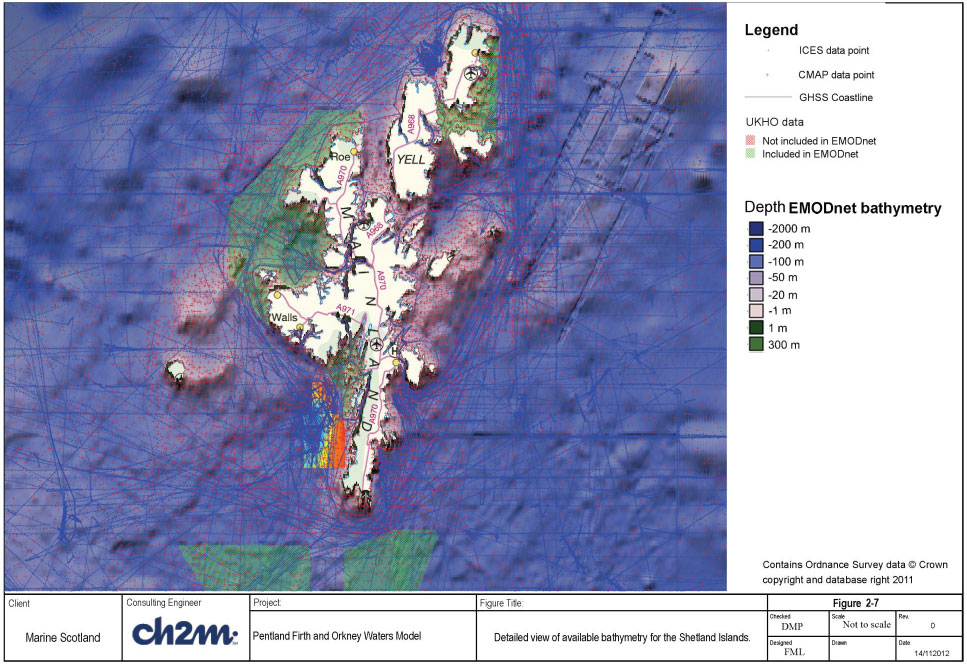
2.3 Forcing Data
2.3.1 Introduction
Forcing data is required for a one year climatological model run of the PFOW flow model and for calibration using observed data for approximate 1 month periods. The following forcing data is required;
- meteorological - including wind speed/stress, atmospheric pressure, surface heat flux, precipitation and evaporation
- hydrological - river flux
- oceanic open boundaries - including temperature, salinity and velocity
- tides
In addition, surface winds and offshore wave boundary data are required for the wave model.
2.3.2 Meteorological forcing
2.3.2.1 UK Met Office Model Data
Two data streams from the Met Office forecast models have been archived at NOC-L for operational modelling:
- for operational tide-surge modelling on the continental shelf, using the 2d tide-surge model ( CS3 and CS3X).
- These data comprise of surface wind and atmospheric pressure only, at 1-h intervals, from May 1991 to present. From 1991 to 1995 the data is at 50 km resolution, post 1995 the data is at 12 km resolution.
- for Irish Sea Observatory operational modelling system, running the 3d baroclinic hydrodynamic model, POLCOMS, on (i) the Atlantic Margin Model ( AMM, ~12km) and (ii) the nested Irish Sea model ( IRS, ~2km). The data comprise the following, from 2004 to 2007 with some gaps, and continuously from 2007 to 2011, all at 12 km resolution:
- Global model output for the Atlantic at 6-hour intervals - 10m wind (E and N components); sea level pressure; low, medium and high level cloud coverage; specific humidity at 1.5m, air temperature at 1.5m; total accumulated precipitation; sensible heat flux
- Mesoscale model output at 3-hour intervals - same variables
2.3.2.2 Climatological Forcing
Climatological forcing was derived from the ERA40 and ERA-Interim datasets, which were used to force the POLCOMS AMM (~12km) model for the 45 year hindcast (1960-2004). See Wakelin et al. (2012) and Holt et al., (2012). A licence to use these data has been provided by the European Centre for Medium range Weather Forecasting ( ECMWF) for this study.
A detailed description of the methodology used to derive the forcing for the 1-year climatology run is provided in the Scottish Shelf Waters Model report (Wolf et al. 2015). A brief description is given as follows: 1) The initial and boundary conditions were taken from a mean of the AMM climatology run; 2) The river climatology data was provided by CEH; 3) The tides were included as a mean tidal year and 4), while the met forcing climatological data was calculated as monthly mean wind-stress, pressures, heating and evaporation minus precipitation from the ERA40 and ERA-Interim datasets.
2.3.3 Meteorological observations
The Marine Scotland Science survey vessel MV Scotia undertook two surveys for this project, one in St Magnus Bay, Shetland (October 2012) and the other in the Hoy Sound, Orkney (Dec, 2012). During these surveys wind measurements were made from the vessel.
2.3.4 Hydrological Data (Fresh Water Inflows)
In order to simulate the effect that river flow has upon salinity in coastal waters, river flux data are required. The Centre for Ecology and Hydrology ( CEH) Grid-to-Grid ( G2G) model is used to supply freshwater inflows to the various coastal models for this study. For the PFOW model the G2G model was extended to provide conditions for the Shetland Isles which were not available in the available dataset at the onset of this project.
The G2G model output provided by CEH are:
1. River discharge data (time series data) at all coastal locations in Scottish waters. The data cover 1 March 2007 to 30 September 2010 at 15 minute intervals.
2. River discharge data (time series data) at all coastal locations around Shetland and Northern Ireland. The data cover 1 March 2007 to 30 September 2010.
3. River discharge climatological data (long term daily/seasonal discharge data) at all coastal locations for Scotland (including Shetland) and Northern Ireland. Daily averaged data was provided, the averaging period covered 1962-2011.
2.3.5 Waves
Two sources of offshore wind and wave data were identified, namely 1) US National Oceanic and Atmospheric Administration ( NOAA) data; 2) UK Met Office data.
The NOAA data is freely available, however comparisons with measured wave data showed that this dataset significantly underestimates wave heights during storms, see Figure 2-8. The data also underestimates the wave climate from the north and overestimates waves from the west-southwest, see Figure 2-9a.
The UK Met Office data is commonly used in UK waters, and it is considered suitable for this study. This data was purchased at four points. The locations and the wave roses at the four points (which are located around the model boundaries) are presented in Figure 2-9b. The wind roses at these locations are also presented in Figure 2-9c.
2.3.6 Tide
For the PFOW Model, the boundary data was derived from NOC-L's Atlantic Margin Model ( AMM) with a 12km resolution. Water levels along with temperature and salinity time series data are extracted from the AMM model and applied at the boundaries of the PFOW model.
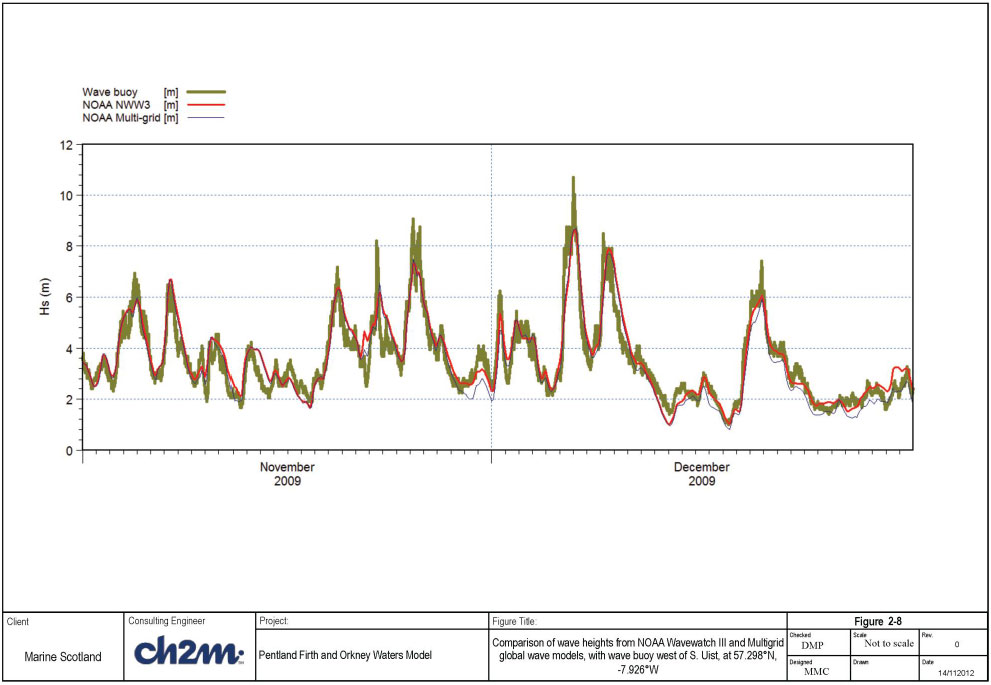
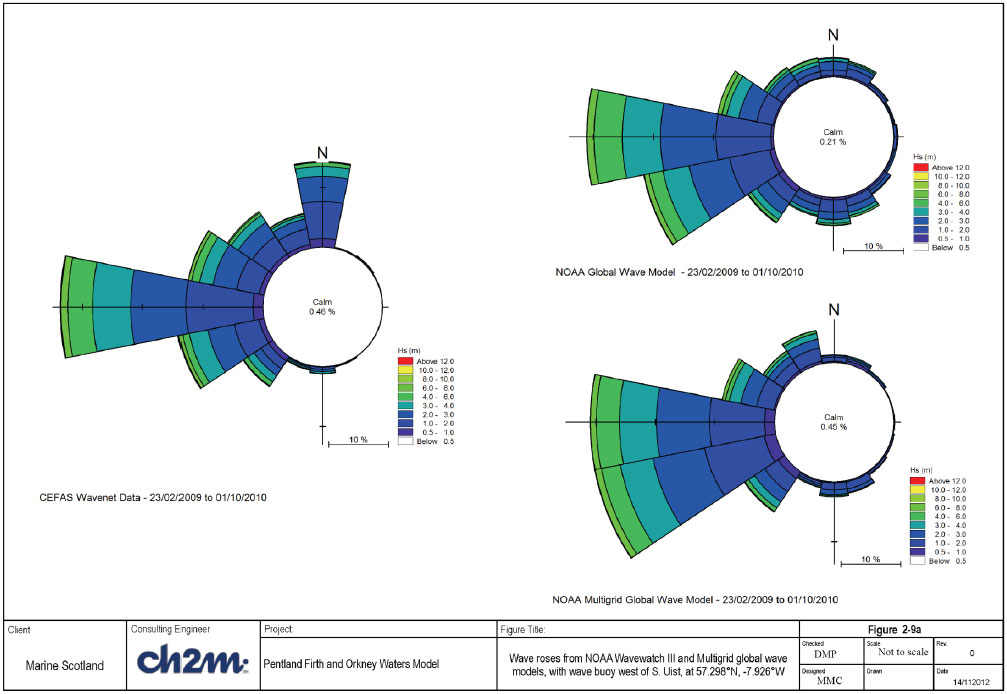
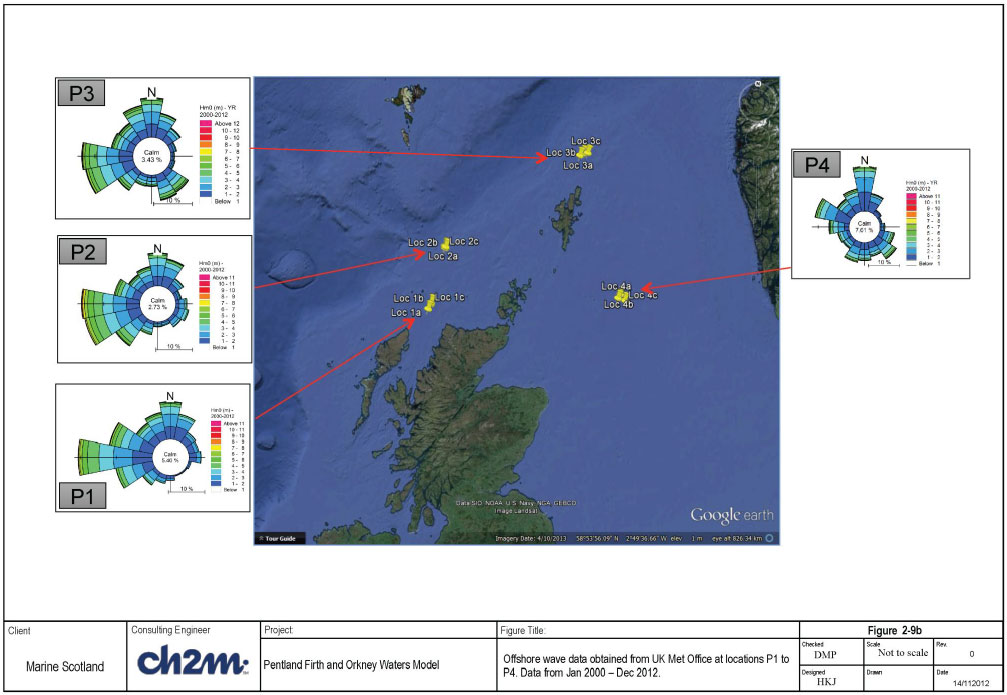
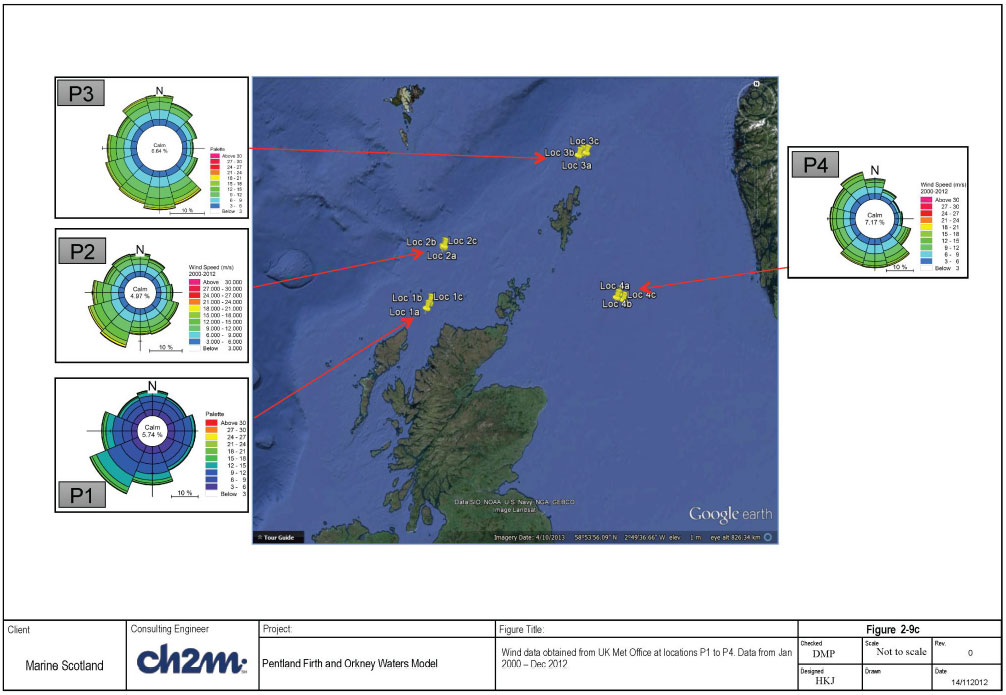
2.4 Calibration Data
2.4.1 Introduction
Calibration is required for water level, currents, temperature, salinity and surface waves against observation datasets for periods of up to 1 month. In addition, the 1 year climatological runs are to be compared against accepted general flow characteristics including residual current speed and direction (seasonal variability) and seasonal temperature and salinity cycles. The available calibration data (observation datasets) are summarised in the sections below.
2.4.2 Water Level
Figure 2-10 shows all the locations of water level observations that are available in the PFOW region. These come from three main sources: tide gauge data from the BODC National Oceanographic Database ( NODB); bottom pressure data from the NODB, analysed tidal data from NOC-L and tide gauge data from SEPA. All of the SEPA gauges (except Rothesay, which ends on 17 th April 2007) have data between 2009 and 2012; most go back to 2001/2. Their locations are shown in Figure 2-11.
In addition, we have access to tidal data from TotalTide - a digital version of the UK Admiralty tide tables, from the UK Hydrographic Office. The locations of these datasets are shown in Figure 2-12a. As these data are based on harmonic analyses, water level estimates for any past or future date are obtainable, via the use of constituents from the Admiralty tide tables. All water level data available post year 2000 are shown in Figure 2-12b.
2.4.3 Currents
Datasets on currents have been found from a number of sources; all locations are shown in Figure 2-13. These come from the BODC National Oceanographic Database ( NODB) and the TotalTide software from UK Hydrographic Office. As Figure 2-14 shows, there are only a few datasets from the BODC National Oceanographic Database since year 2000. In addition, some of these datasets (shown in red) may not be freely available. In some cases, vertical current profiles are available; these are shown in Figure 2-15a.
In the Pentland Firth, interest in tidal energy has led to the existence of other datasets. Baston and Harris (2011) presented results from Acoustic Doppler Current Profiler ( ADCP) data collected in 2001. Also the Environmental Research Institute collected current data via ADCP in the Pentland Firth in 2009 (Figure 2-15a).
The methodology used by TotalTide for calculating currents is not known. In addition, these data have been estimated for the use of shipping; therefore, a greater weighting may be placed on surface currents than currents near the sea bed.
Additionally the MV Scotia collected current and CTD measurements in and around St Magnus Bay in Shetland in October 2012 and in Hoy Sound in Orkney in December 2012 (shown as ADCP Data from MV Scotia on Figure 2-15a with more detail shown on Figures 2-15b and 2-15c). This data is considered useful for the calibration of the PFOW model.
The Atlas of UK Marine Renewable Energy Resources ( www.renewables-atlas.info) contains information on peak tidal current speeds over a mean spring and a mean neap tide. The dataset was derived from the POL HRCS Model, with peak spring and neap current speeds calculated from the major 2 or 4 tidal harmonics. Although this dataset is limited, it is freely available on a 0.0167° x 0.025° (latitude x longitude) grid throughout the region shown in Figure 2-16.
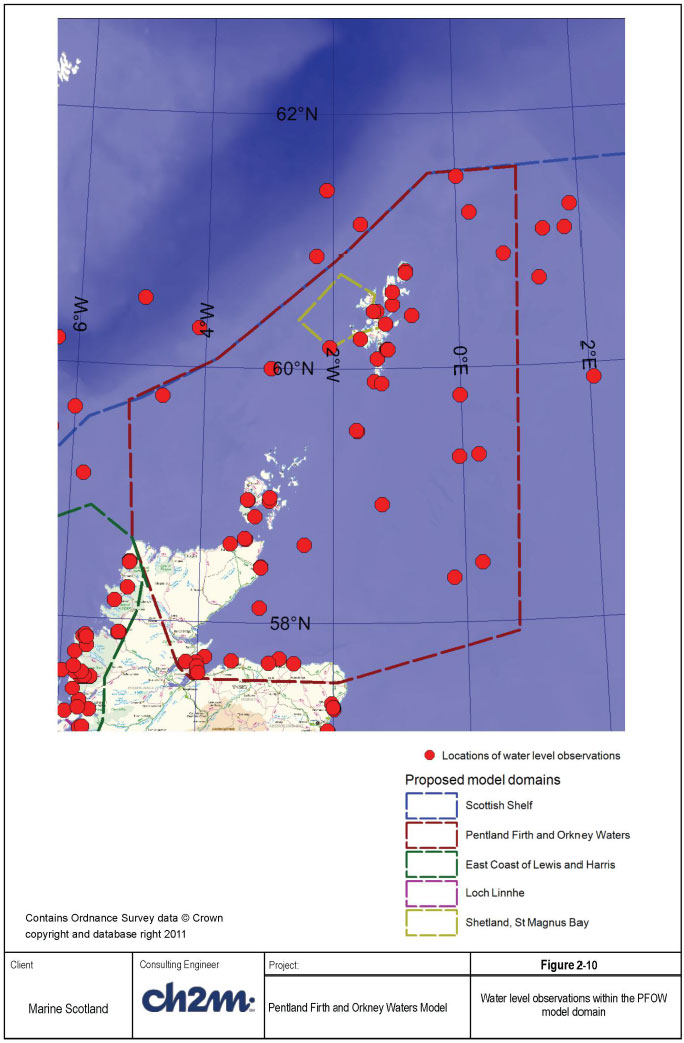
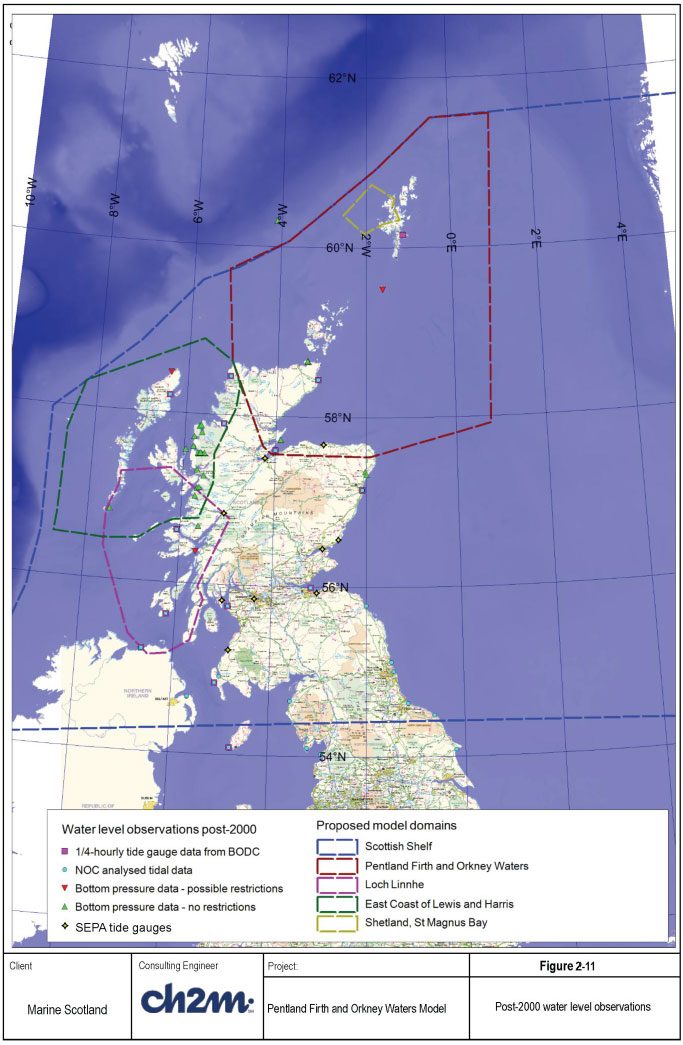
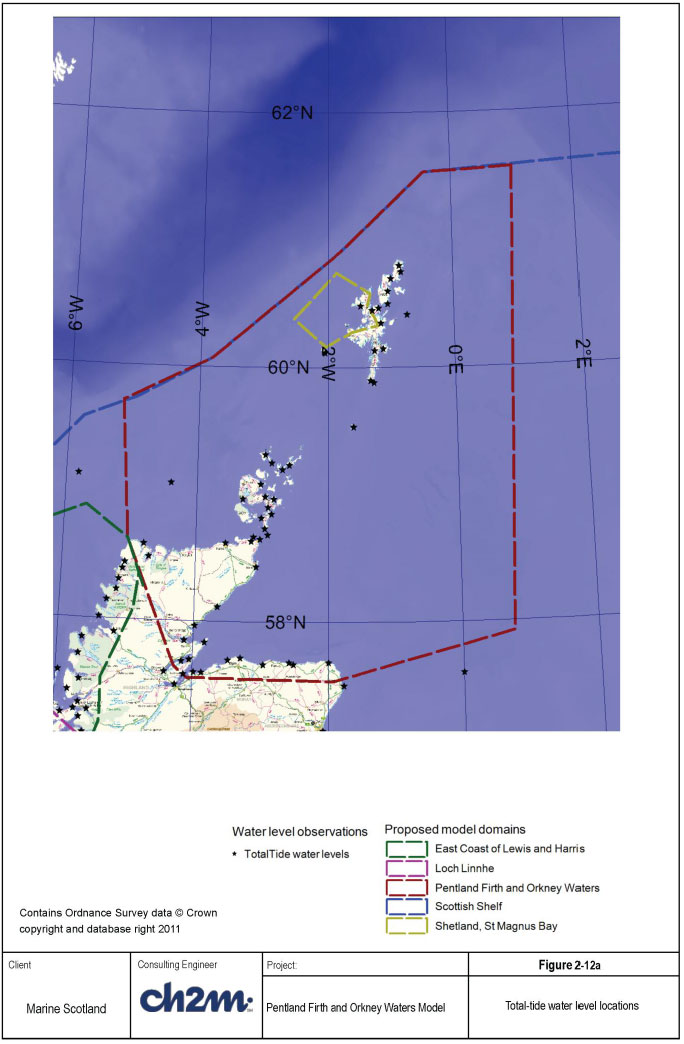
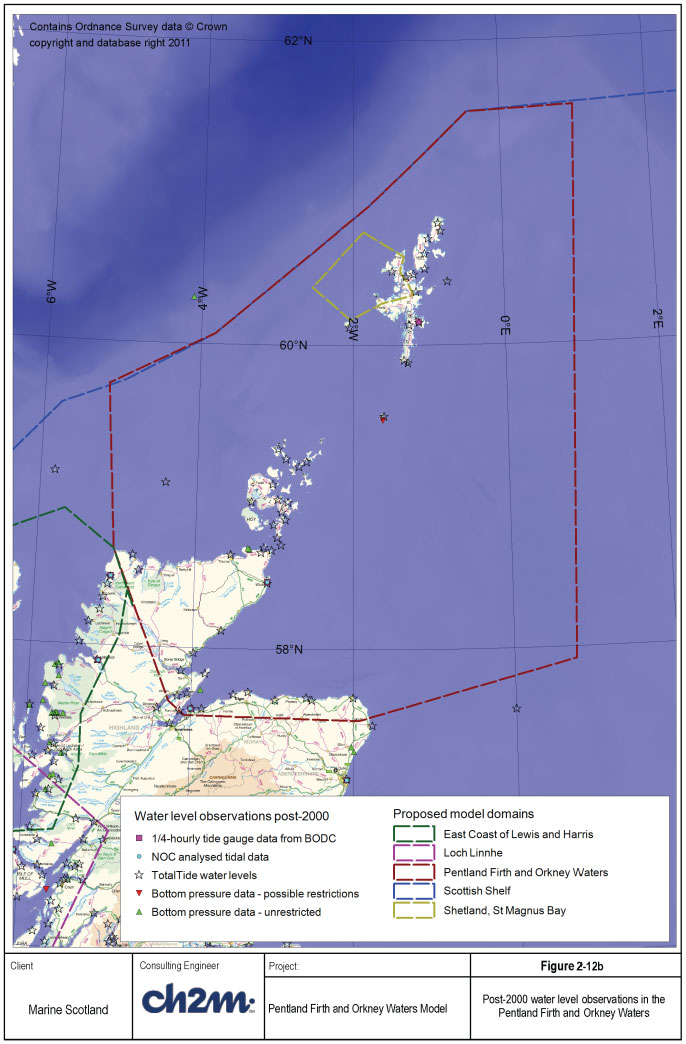
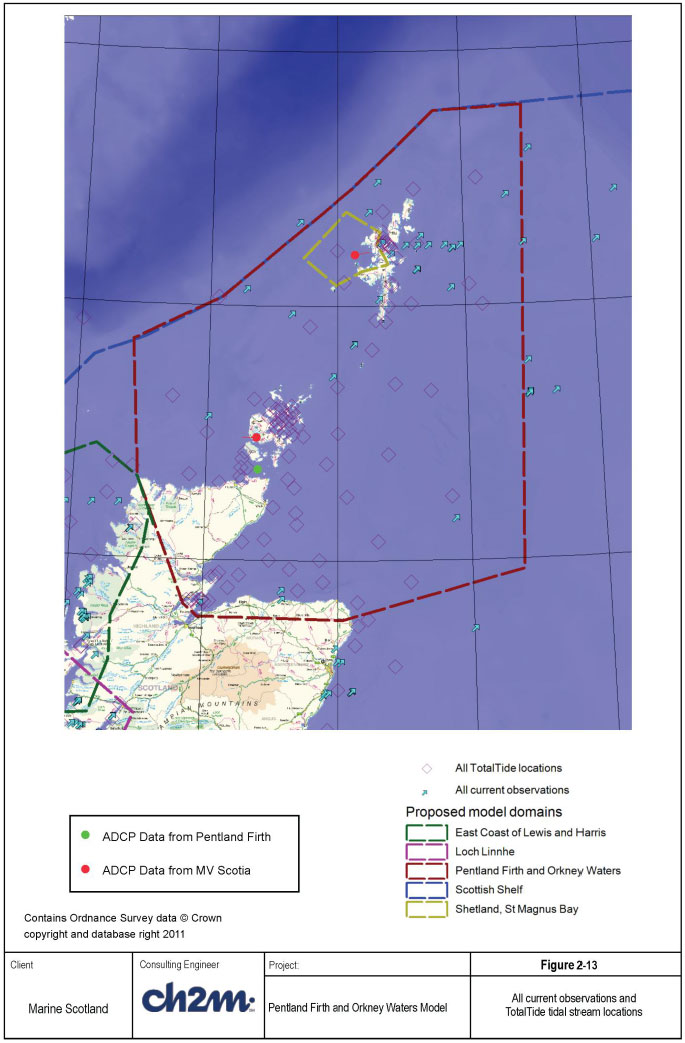
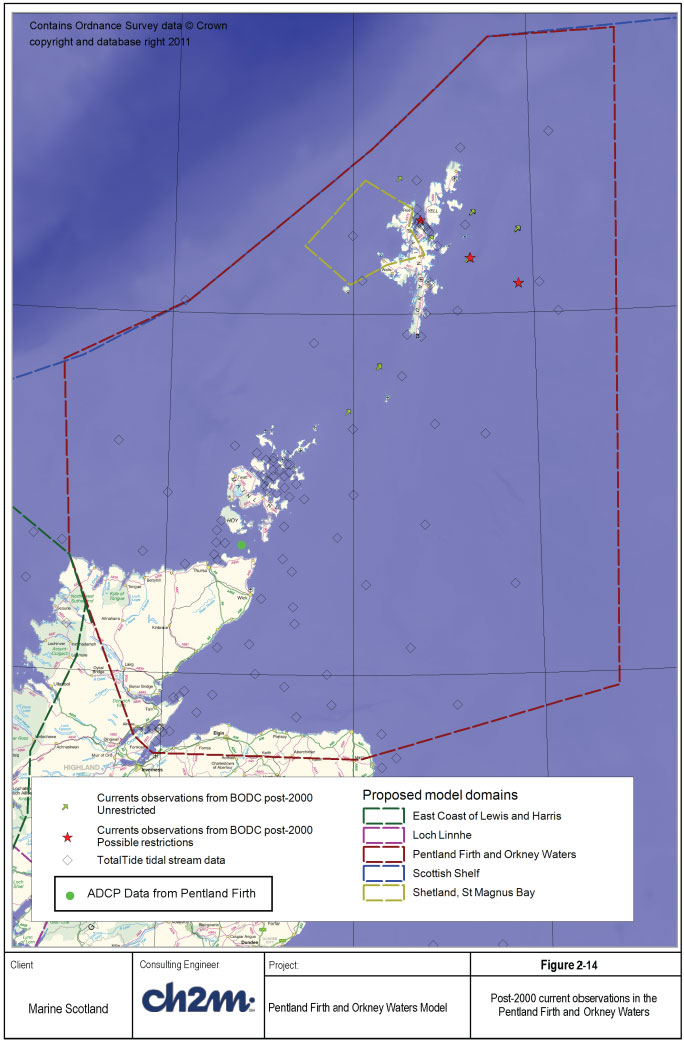
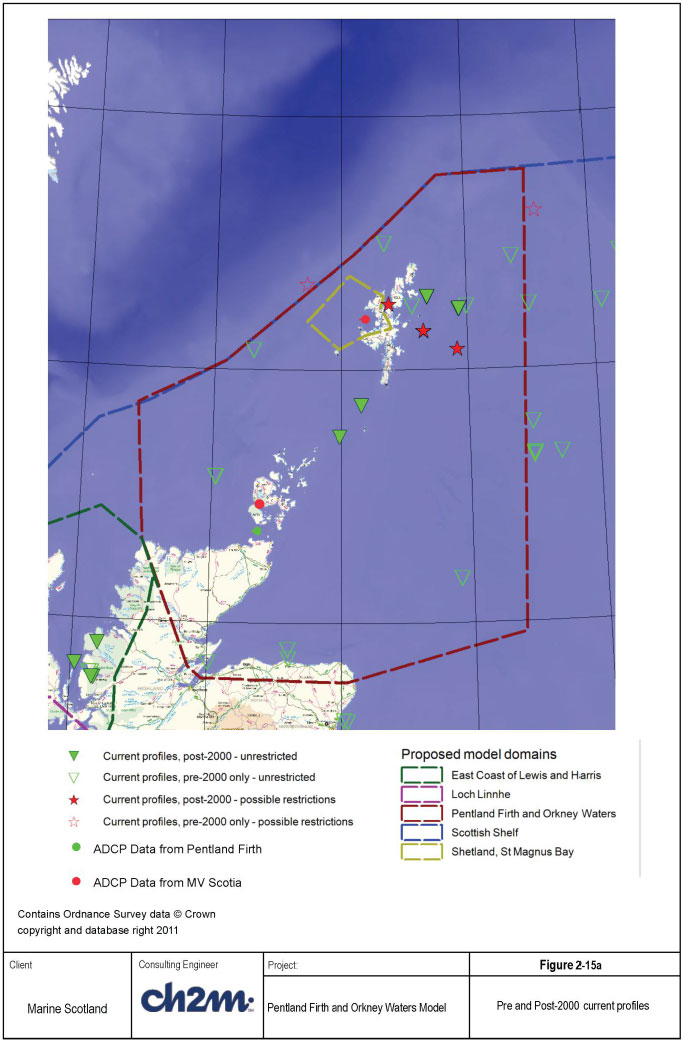
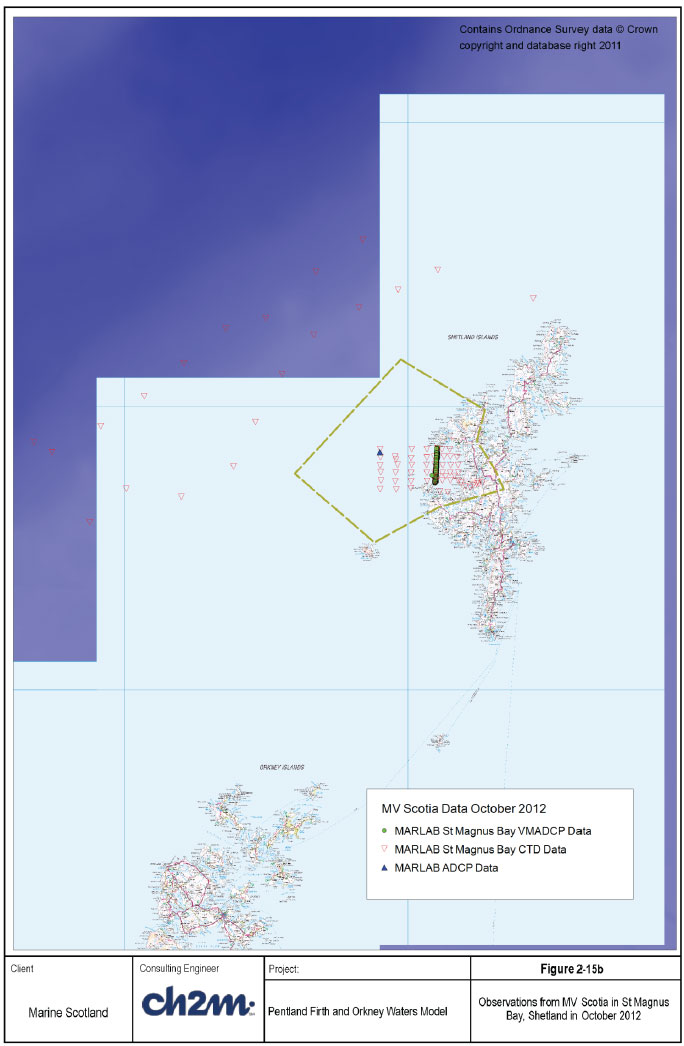
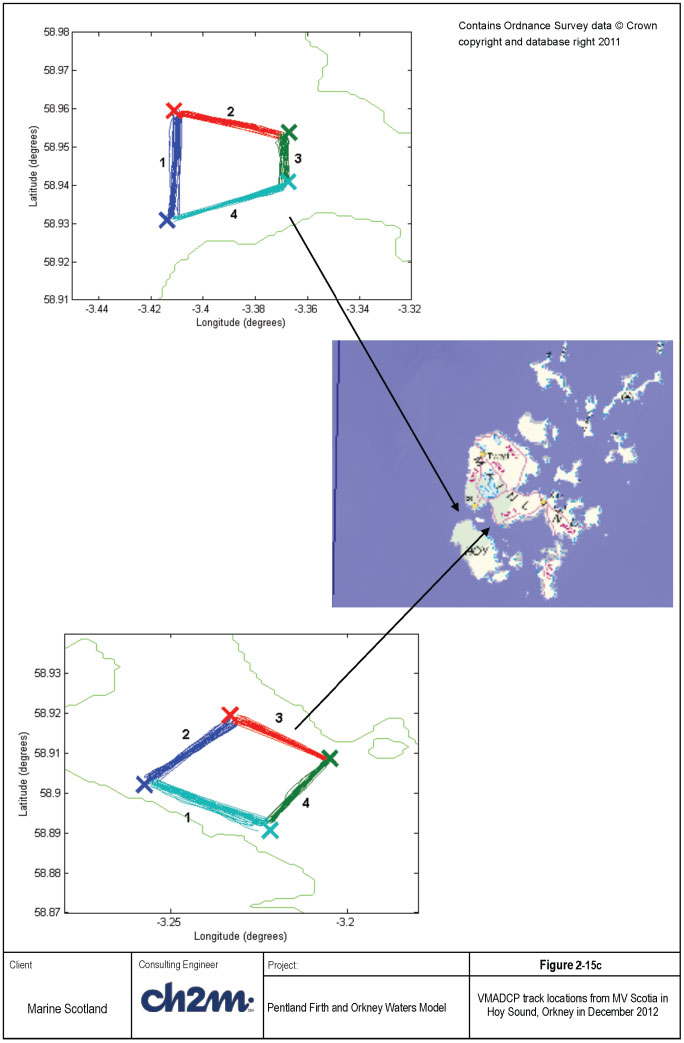
2.4.4 Waves
The Atlas of UK Marine Renewable Energy Resources ( www.renewables-atlas.info) contains information on monthly, seasonal and annual mean significant wave heights. Waves were calculated from the Met Office 2 nd generation wave model. Although this dataset is limited, it is freely available, largely presented on a 0.125° x 0.167° (latitude x longitude) grid throughout the region shown in Figure 2-16. This data is useful for comparison with the climatological wave data derived from this study.
Wave buoy data from CEFAS WaveNet programme is freely available for non-commercial purposes. In addition, some wave data is available from the BODC National Oceanographic Database, both from wave buoys and pressure gauges; however there are licensing restrictions on some of these datasets. Locations of available wave data from both sources, showing possible restrictions and data available since 2000, are shown in Figure 2-17.
Datasets from wave buoys exist within the proposed model domain (Figure 2-17). However, all but one of these datasets exists close to the shore. The Moray Firth WaveNet site is located over 20 km from the shore, and contains wave heights, periods and directions since August 2008. Other offshore datasets exist near the proposed model domain, but are not be freely available; in some cases these are from oil platforms. The wave data nearest the Pentland Firth are at Dounreay (water depth of approx. 20 m, from October 1997 to May 2001); however, there are no wave directions for this dataset. Nevertheless, these datasets are useful for calibration purposes.
2.4.5 Temperature and Salinity
Temperature and salinity validation was carried out using selected hydrographic stations which are identified from the British Oceanographic Data Centre data holdings for UK. There are a very large number of datasets from CTD and bottle casts, both from the BODC National Oceanographic Database and the ICES database. Additionally, some of the CEFAS WaveNet buoys record sea surface temperature.
Figure 2-18 shows the locations of the temperature observations and Figure 2-19 shows the locations of the salinity observations. As Figure 2-20 shows, the temperature and salinity observations are available throughout the last two decades, with many observations throughout all model domains having occurred over the last two years. Figure 2-21 shows which of these observations include profiles over the entire water depth. Most temperature and salinity observations occurred at the same location and time. Figures 2-22a and 2-22b show there are sufficient temperature and salinity profiles within the model domain, both during the 2001 and 2009 ADCP observations.
In addition, the Ocean Data analYsis System for SEA ( ODYSSEA) dataset is a re-analysis of satellite observations of sea surface temperature. Daily mean average sea surface temperatures since 01/10/2007 have been obtained, on a 0.1° x 0.1° grid.
The results from the climatic run are compared with climatological atlas information for sea surface temperature and salinity, from the World Ocean Atlas ( WOA) and International Council for Exploration of the Seas ( ICES) climatological datasets.
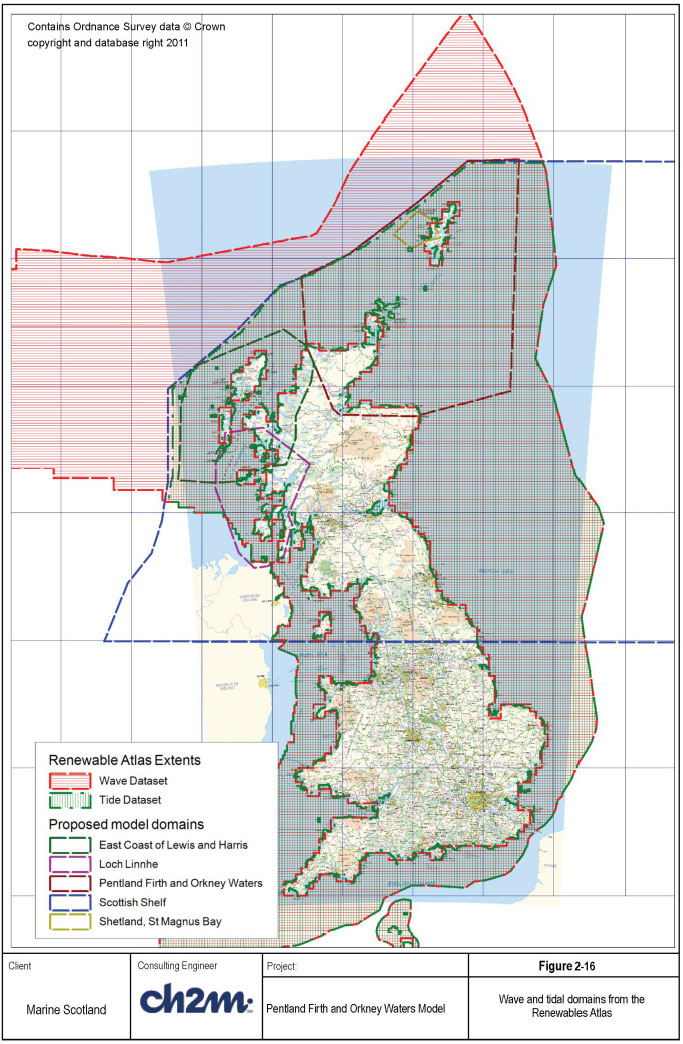
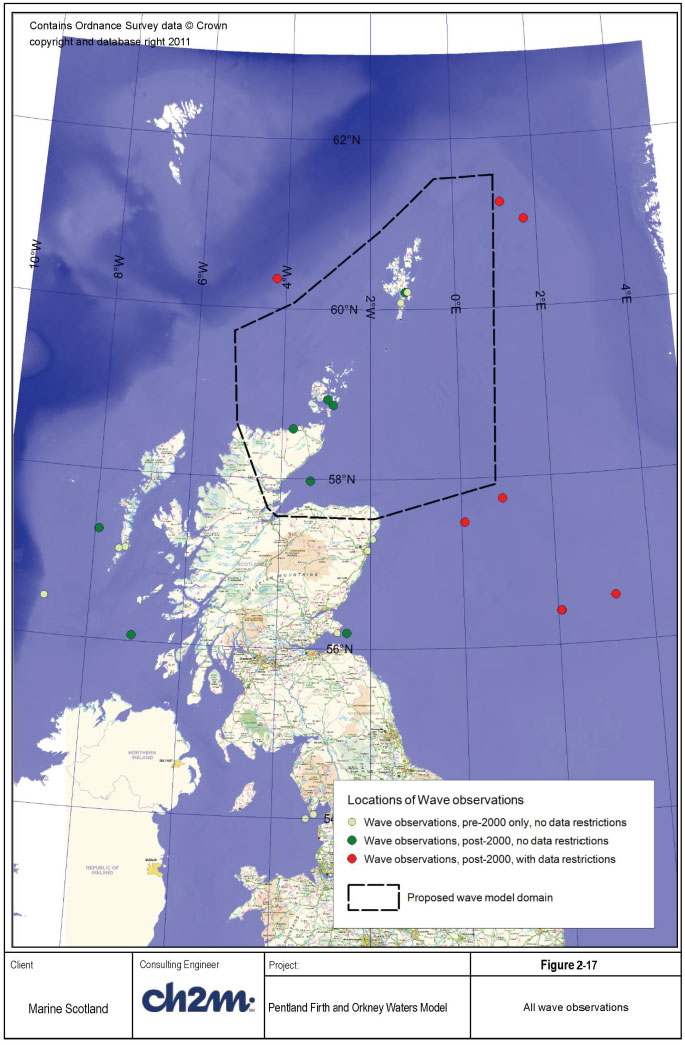
2.4.6 Summary of data availability for the PFOW model
A summary of the data available for calibration of the PFOW hydrodynamic model is presented in Table 2-1. It can be seen that the year 2009 is the period where a complete set of the required data is available. 2001 will be used for model calibration, validation will be carried out for hydrodynamic in 2012 and for temperature and salinity in 2009.
Table 2-1 Case Study models and available data
| Sub model |
Year |
Water level |
Currents |
Temperature /salinity |
Meteorological |
Wind |
River |
|---|---|---|---|---|---|---|---|
| Pentland Firth and Orkney Waters |
2001 |
√ | √ | √ | X |
√ | X |
| 2009 |
√ | √ | √ | √ | √ | √ | |
| 2012 |
√ | √ | √ | X |
√ | X |
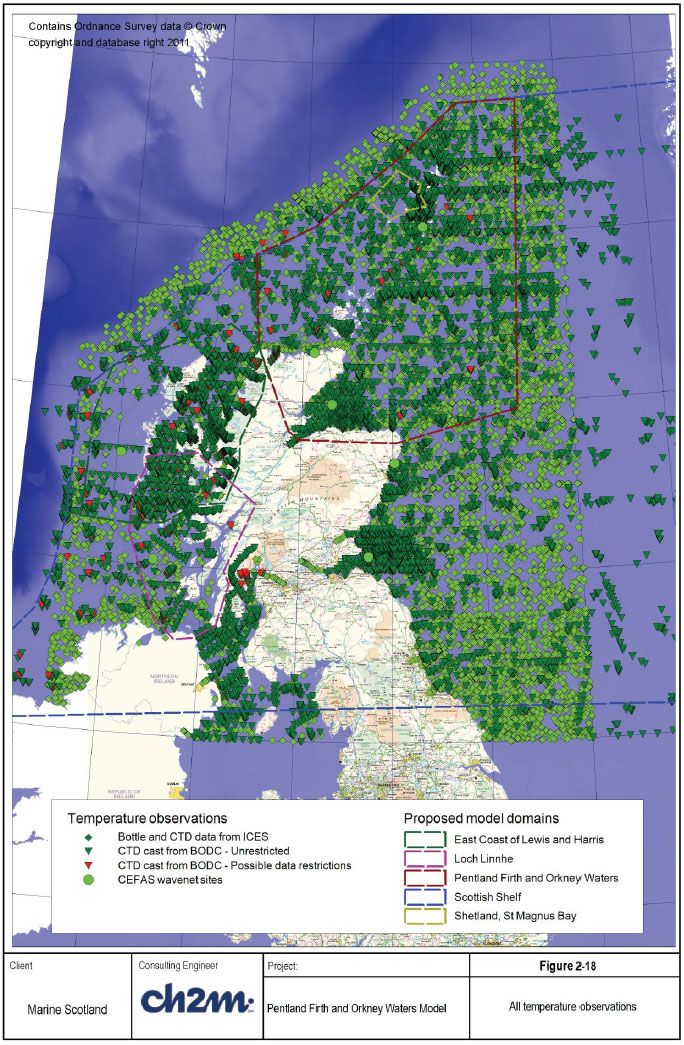
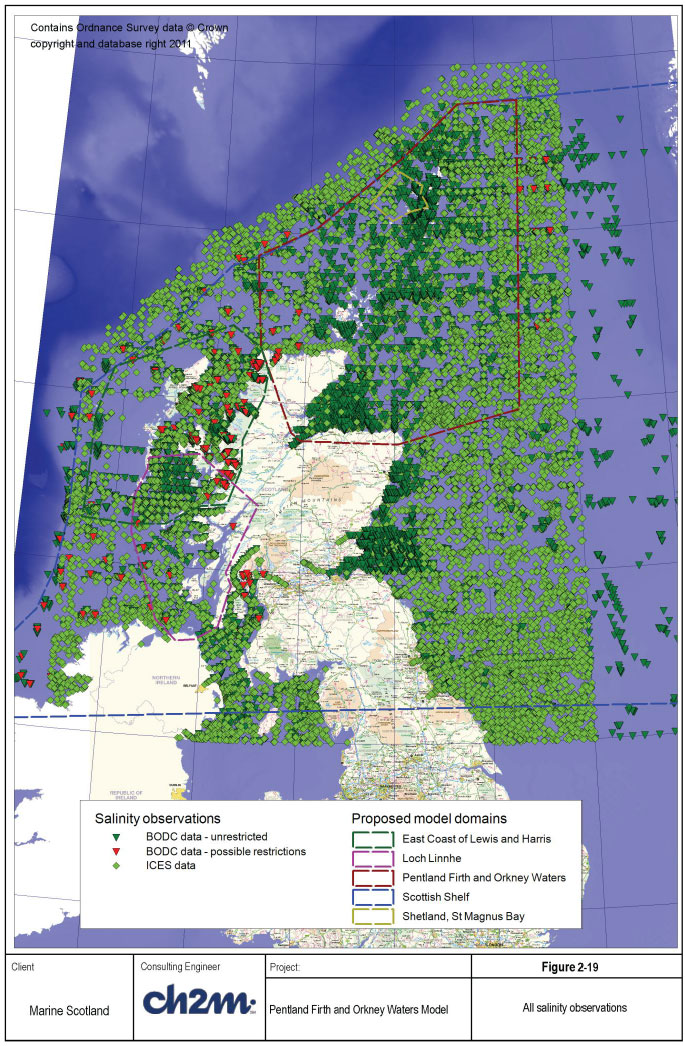
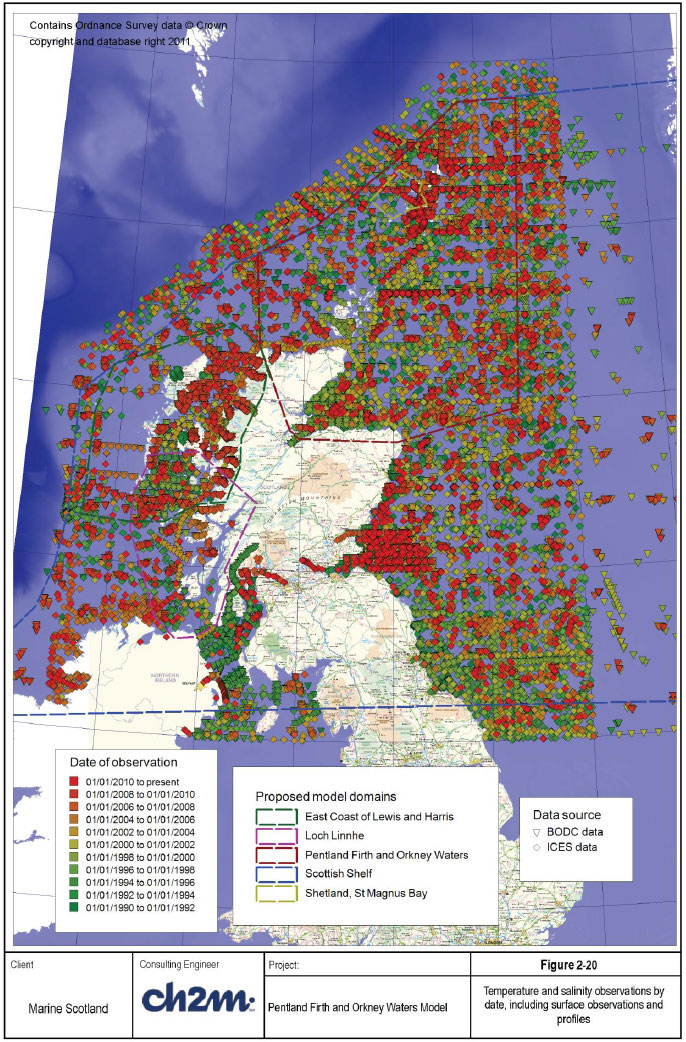
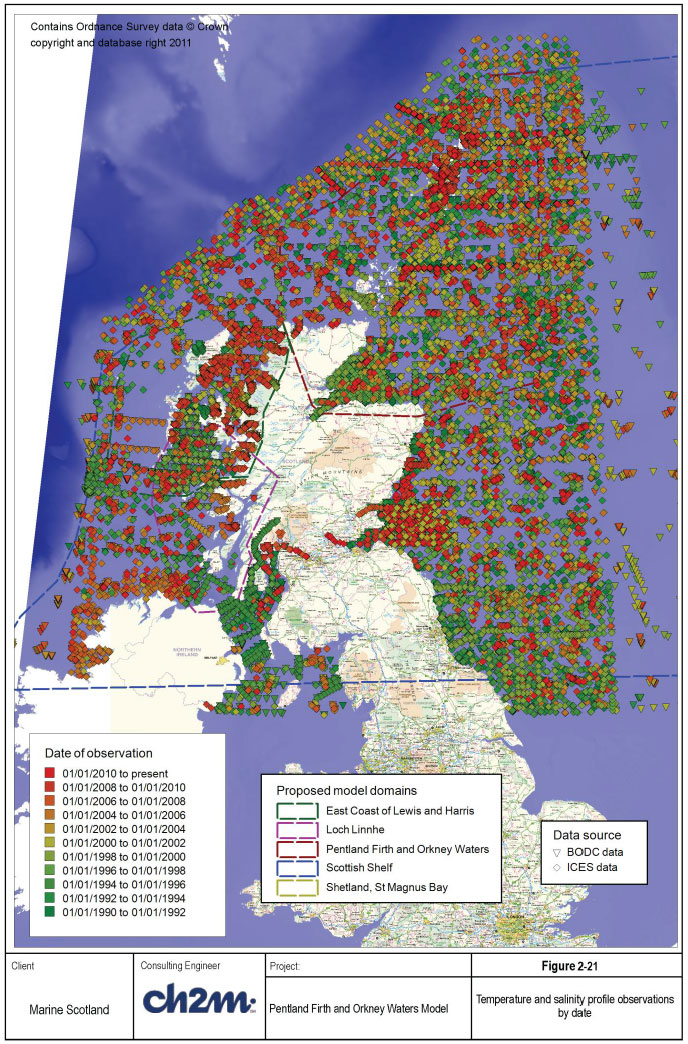
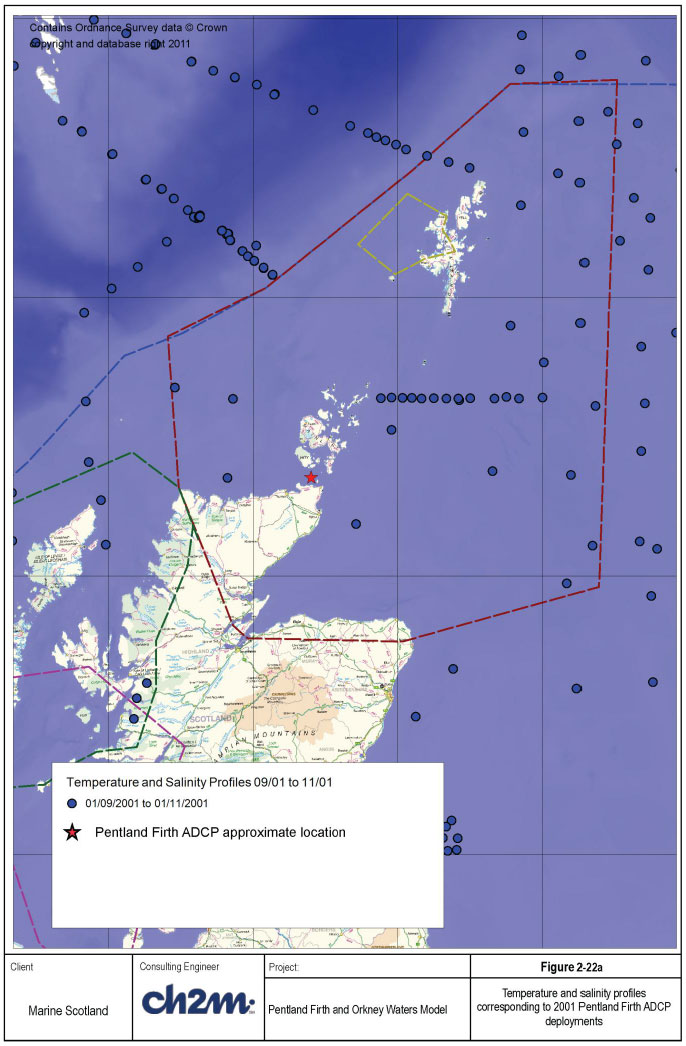
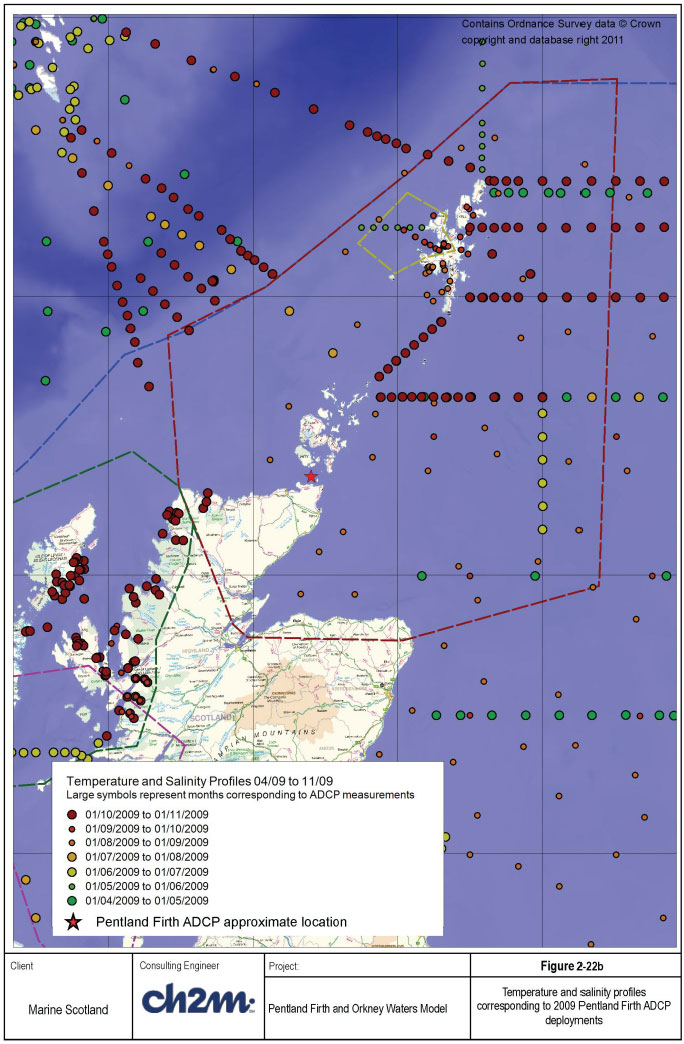
2.5 Summary
A review has been undertaken to identify and collate data that are relevant to the setting up, forcing and calibration of the PFOW models. It has been found that there are many datasets available providing coverage over a wide spatial and temporal field.
2.5.1 Bathymetry
The EMODnet data is considered appropriate for use as the base bathymetry for model construction. This data is used as our base bathymetry data (coarse resolution), but is replaced with higher resolution data where available. UKHO data and other higher resolution datasets from ICES and Marine Scotland have been used to replace the coarser resolution data in areas that they overlap, with appropriate checks for consistency. However even with these data there are areas which have been identified in the data review report (Halcrow, 2012) as not having sufficient bathymetry data at a fine enough resolution. In this case data from digitised Admiralty Charts have been used.
2.5.2 Forcing data
For this case study, tidal forcing, temperature and salinity data have been obtained from the NOC-L AMM model to provide boundary conditions to the PFOW model.
Meteorological forcing for the PFOW model are derived from the Met Office model data that NOC-L holds. The Met Office data provides wind data from 1991 to present day, however other parameters such as sea level pressure, low, medium and high level cloud coverage, specific humidity at 1.5m, air temperature at 1.5m, total accumulated precipitation and sensible heat flux are only available from 2007 to 2011. This therefore limits the periods where calibration data are available coincident with full meteorological forcing. For the 2009 validation period (used for this study), the full meteorological forcing is available.
Fluvial inputs are derived from G2G river flow data obtained from CEH for the PFOW area. This data includes additional G2G runs undertaken by CEH to provide river flow data in Shetland.
Wave data for use as boundary data in the PFOW wave model has been obtained from the UK Met Office.
2.5.3 Calibration Data
Section 2.4.6 presents information about which data are available for the PFOW model. In general there is sufficient data with which to undertake calibration for waves, water level, currents, temperature and salinity for the year 2009. Thus, the calibration of the model is carried out for the year 2001 and validation is carried out for the year 2012 and 2009.
Contact
There is a problem
Thanks for your feedback